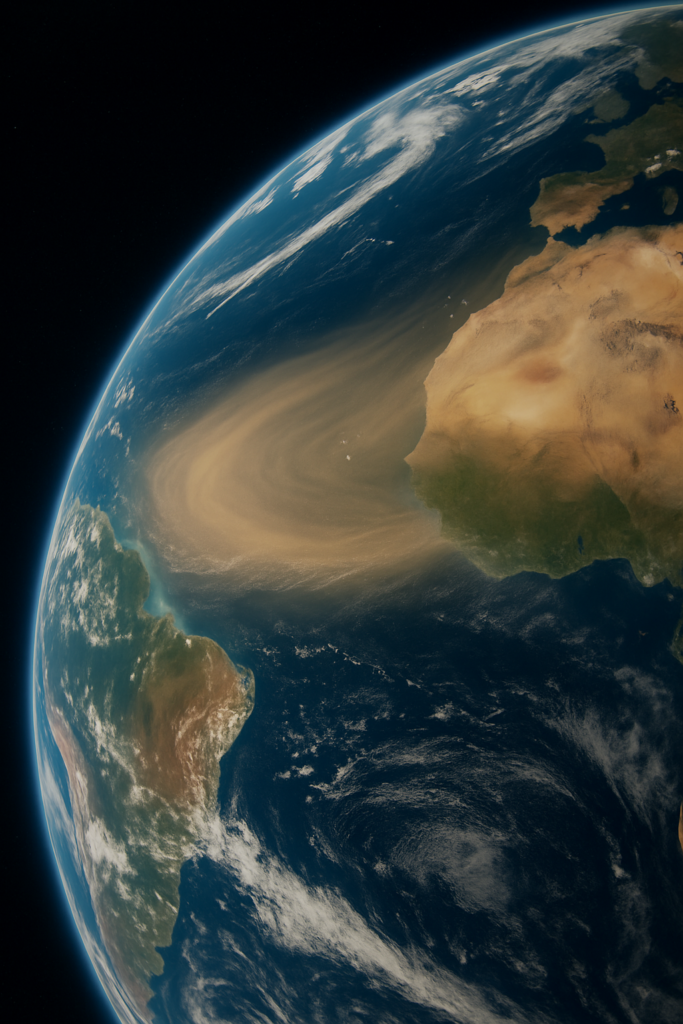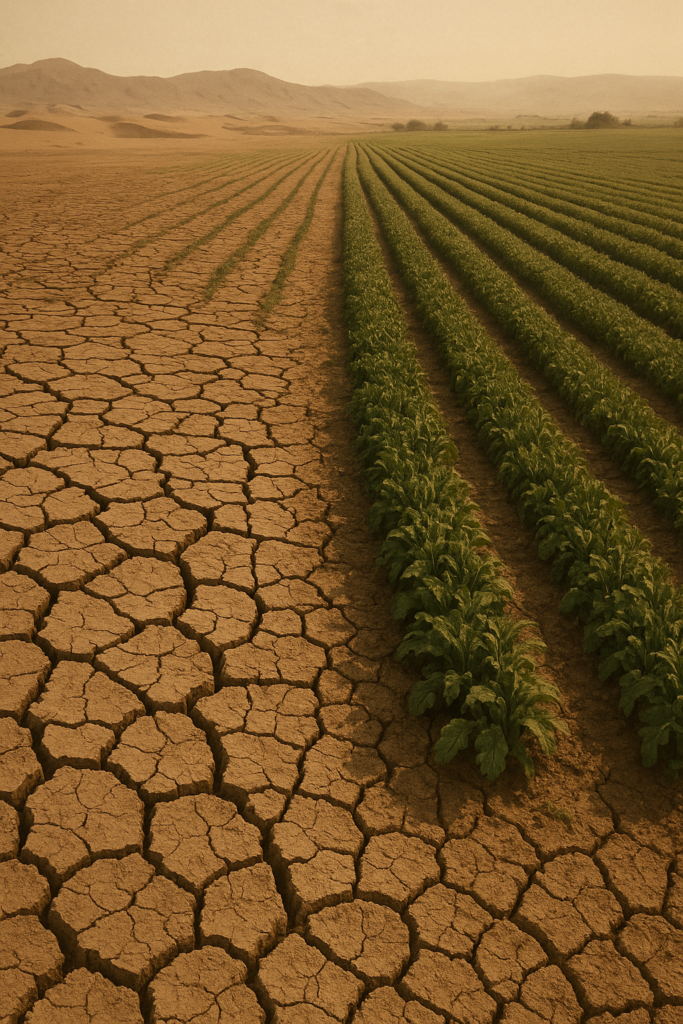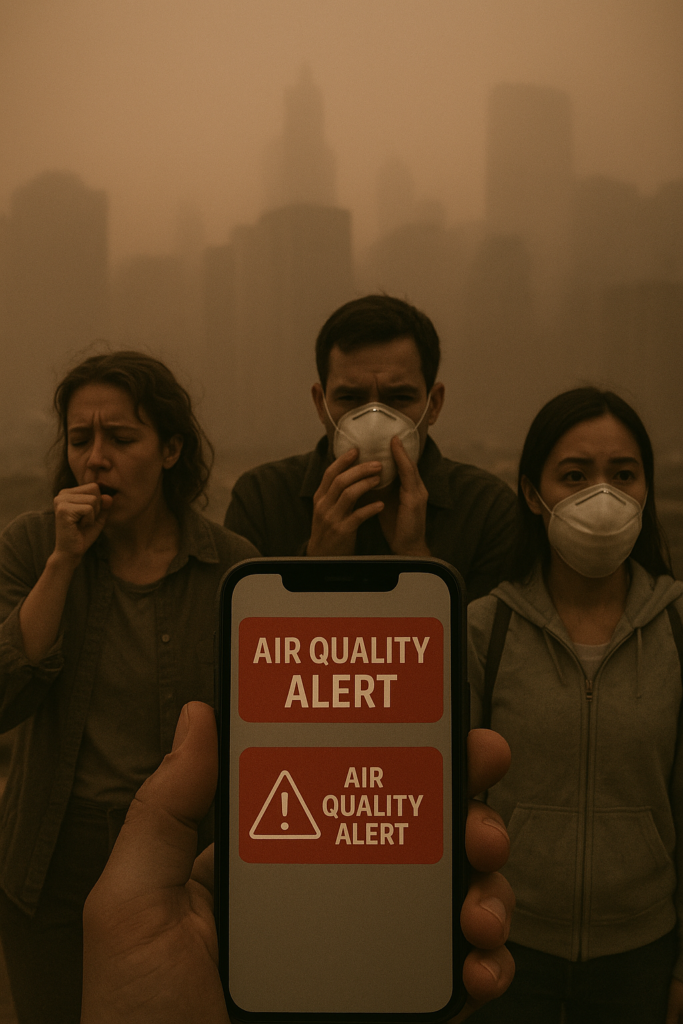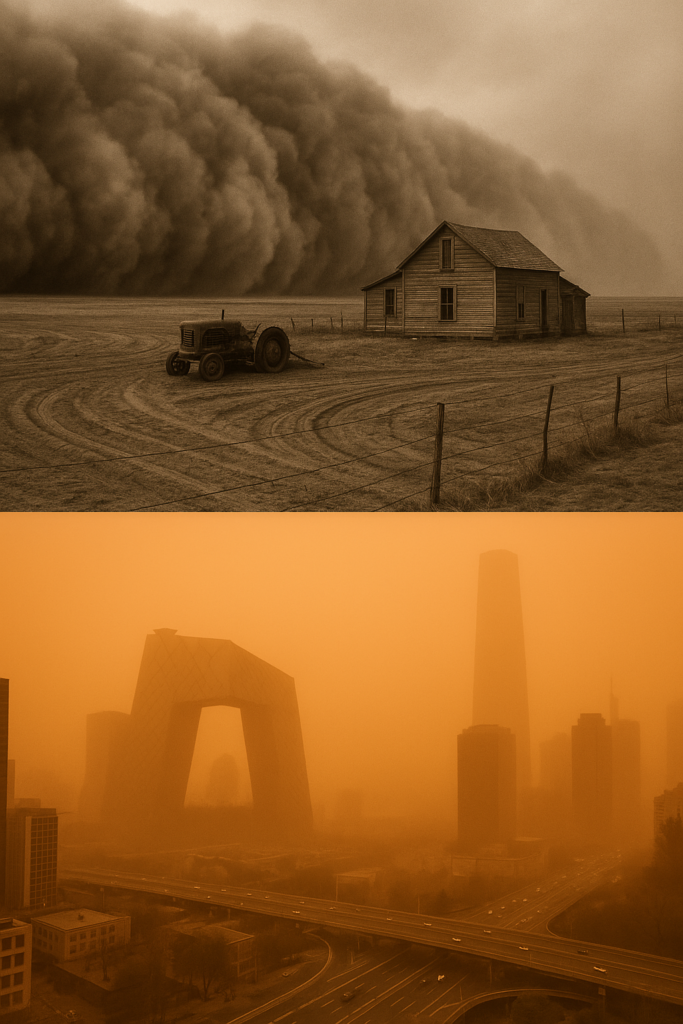Particles in the Wind, Stories in the Sky

The storm begins long before anyone notices.
A distant gust, the rustle of desiccated shrubs, the lift of dry topsoil no heavier than a whisper. And then, almost without warning, the world turns a muted brown.
Across Africa’s Sahara Desert, where land stretches in silence, a wind rises. It stirs ancient sands and stings modern cities. Within hours, it becomes a global traveler — a dusty envoy capable of crossing oceans, reshaping weather systems, choking skylines, and fertilizing forests.
This is not just a sandstorm.
It is a dust storm — a transcontinental phenomenon that blurs the lines between continents, climates, and consequences.
From Sahara to the Atlantic: A Yearly Migration of Dust
Each year, between late spring and early autumn, a dense, dry air mass forms over North Africa. Meteorologists call it the Saharan Air Layer (SAL) — a hot, dust-laden plume that rises thousands of feet into the atmosphere. Propelled westward by trade winds, it embarks on a journey across the Atlantic Ocean.
In 2020, one such cloud, dubbed the “Godzilla dust storm”, darkened the skies over the Caribbean and smothered the Gulf Coast of the United States in an eerie haze. Its particles, some scarcely larger than smoke, had originated over 5,000 kilometers away.
Yet this wasn’t a fluke. It was part of a regular rhythm — one that ties together continents through the invisible threads of airborne dust.

A satellite view of the Saharan Air Layer drifting over the Atlantic Ocean
A Double-Edged Force of Nature
Global dust storms are nothing new. But only in the past few decades have scientists begun to fully grasp their paradoxical power — both as agents of destruction and unlikely harbingers of life.
The Good:
- Fertilizing the Amazon: According to NASA, more than 22,000 tons of phosphorus-rich Saharan dust settle in the Amazon Basin every year, replenishing nutrient-poor soils and sustaining one of Earth’s most vital ecosystems.
- Feeding the Oceans: Dust storms deliver iron, a scarce nutrient, to remote parts of the ocean, stimulating phytoplankton growth — the base of the marine food chain and a major carbon sink.

The Bad:
- Worsening Air Quality: Fine particles, especially PM2.5, can penetrate deep into human lungs, exacerbating asthma, triggering cardiovascular episodes, and increasing mortality rates.
- Altering Weather Patterns: By affecting cloud formation and solar radiation, large-scale dust events can suppress rainfall and contribute to drought — or conversely, provoke flash flooding when they mix with storm systems.

“Dust doesn’t just fall,” says Dr. Angela Guerrero, an atmospheric scientist with the NOAA. “It hovers, it travels, and it transforms the world it touches — often in ways we don’t expect.”
Dust as Climate Barometer
Dust storms are becoming more frequent and more intense — a fact that’s worrying climatologists around the globe.
Several factors are at play:
- Rising global temperatures dry out soils, making them more vulnerable to erosion.
- Deforestation and overgrazing reduce ground cover, allowing winds to lift more dust.
- Land degradation and desertification — often human-driven — expand the reach of arid zones.
Data from the Intergovernmental Panel on Climate Change (IPCC) and satellite missions like NASA’s CALIPSO confirm it: the 21st century is seeing more dust, in more places, than ever before.
Even regions not traditionally associated with dust — such as Europe and parts of the U.S. Midwest — are now reporting increased levels of airborne particulates due to changing wind patterns and prolonged drought.

Health, Visibility, and the Price of Breath
Dust storms don’t always announce themselves dramatically. Often, they arrive quietly — as a light haze, a dry throat, an itchy eye. But the real threat lies in what can’t be seen.
Particulate matter smaller than 2.5 microns — PM2.5 — is linked to respiratory and cardiovascular disease. During major dust intrusions, cities like Miami, Madrid, and Tehran have recorded hazardous air quality indexes, prompting governments to issue shelter-in-place advisories.
Airports have been shut down. Supply chains stalled. Emergency rooms filled with coughing patients. The impacts are silent, widespread, and growing.

Dust Across History: A Legacy of Wind and Time
In 1935, a storm known as Black Sunday swept across the Great Plains of the United States, turning day into night. It marked the peak of the Dust Bowl — a human-made ecological catastrophe born from poor farming practices and extreme drought.
That same year, nearly 70 years later, Beijing would suffer through an orange-brown haze carried from the Gobi Desert. And in 2023, Nairobi reported its first Saharan dust intrusion — a signal that global dust circulation may be shifting.
What connects these events is not geography, but global atmospheric mobility. Dust doesn’t stop for oceans or borders. It moves with the jet stream. It joins storms. It settles — sometimes months later — on snowfields in the Alps, glaciers in Greenland, or skyscrapers in New York.

The Journey of a Particle
From the moment a particle is lifted into the air over Mali or Turkmenistan, it begins a high-stakes journey.
In the first hour, it may drift 200 kilometers.
In the next day, it may cross an ocean.
In a week, it might circle the planet.
During that time, it may:
- Reflect or absorb sunlight, influencing global temperatures
- Serve as a cloud condensation nucleus, helping clouds form
- Combine with pollutants, increasing toxicity
- Enter the lungs of a child in Barbados, a tourist in Athens, or a farmer in Arizona
“The journey of a single dust particle is complex and chaotic,” says Dr. Yuki Yamamoto, a climate physicist at the University of Tokyo. “But collectively, they create patterns — patterns we must study, because they speak to the planet’s health.”

What Can Be Done?
We can’t stop dust storms entirely — nor should we. But we can mitigate their most harmful impacts.
On a local level:
- Reforestation and sustainable agriculture can reduce topsoil loss
- Better land use policies can prevent desertification
- Urban planning can adapt to lower visibility and air pollution risk
On a personal level:
- Monitor air quality (via apps like AirVisual or IQAir)
- Use HEPA filters indoors
- Wear protective masks during dust alerts
- Advocate for policies addressing land degradation and climate adaptation
Conclusion: Listening to the Desert

Global dust storms are more than just meteorological curiosities. They are planetary messengers — whispering stories of climate, land, wind, and interconnection. They begin in the silence of deserts, but their message echoes across skies, seas, and cities.
To understand dust is to understand the Earth’s changing heartbeat — a rhythm carried not in sound, but in particles riding the wind.
Further Reading
Desertification in the 21st Century: A Silent Crisis
The Saharan Air Layer: How Dust Controls Hurricanes
How PM2.5 Affects the Human Body

